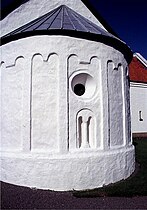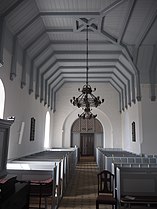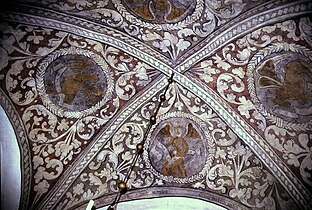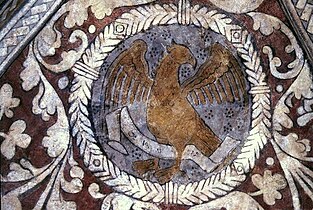Ruts Kirke
The Ruts Kirke is a Romanesque church on the Danish island of Bornholm . It is located on a 130 m high hill, the third highest point on Bornholm, northeast of Hasle . From the church hill you have a wide view over large parts of North Bornholm to the south coast of Sweden on the horizon, which is why the church used to be used as a navigation mark.
The church was originally named after the Archangel Michael , but was popularly called Røs kirke , Latin ecclesia Rutziana, with an old field name . This name was interpreted in 1671 by the teacher Rasmus Pedersen Ravn as Ruths Kirke "after the Moabite woman Rut ", and this name has established itself.
History and architecture
The building, erected in the 12th century, initially consisted of an apse , choir and nave , a tower and a vestibule were added to the south in the Romanesque period; of which the apse, the choir and the south wall of the nave still stand today. In 1877 the church was given an extension in the north that was open to the nave in full height and width. The original tower, the north wall of the nave and the vestibule were demolished in 1886, the nave was extended by three meters to the west and a new tower was added, which has since served as an entrance and made the vestibule superfluous. The outside of the apse is unusually richly decorated with pilaster strips , an arched frieze and a decorative niche with a column.
The two-storey bell tower from the 2nd half of the 16th century is probably the oldest on Bornholm and consists of a stone basement with a barrel vault and a half-timbered bell storey. In contrast to the other Bell towers on Bornholm, it has only one gate, so it never served as an entrance to the churchyard. The two bells, one from 1580 from Lübeck and one from 1631 from Copenhagen, have been hanging in the new tower since 1886, so that the bell tower has been without function since then.
The apse has retained its Romanesque hemispherical vault. The choir originally had a wooden roof, which was replaced by a ribbed vault at the end of the 15th century . The ship has a wooden roof, the entrance hall in the tower has a barrel vault. The east wall of the nave has two side altar niches next to the choir arch.
Furnishing
The old renaissance altarpiece from around 1625 hangs today in the entrance hall in the tower, its crown is missing. As usual on Bornholm, it has two fields, they show paintings by Heinrich Möhlen from 1753, on the left the baptism of Jesus , on the right the Lord's Supper . Today's altar crucifix is modern and offers a view of the round apse window.
The almost cylindrical baptismal font made of granite is Romanesque, the baptismal bowl from the second half of the 16th century comes from southern Germany and shows the Annunciation . The pulpit and organ are modern.
In 1908, frescoes from the second half of the 16th century were discovered on the late Gothic choir vaults and then restored. They show medallions with the symbols of the evangelists in Renaissance tendrils .
Web links
Individual evidence
- ↑ a b c Ruts Kirke (Danish), accessed October 12, 2019.
- ↑ Borringholms Krønike (first print 1926), p. 149
- ↑ a b Bornholms Museum (ed.): Bornholms old churches. 1999, ISBN 87 88 179 41 9 .
Coordinates: 55 ° 12 ′ 54.8 ″ N , 14 ° 45 ′ 0.5 ″ E






